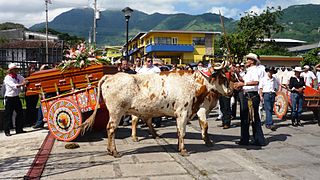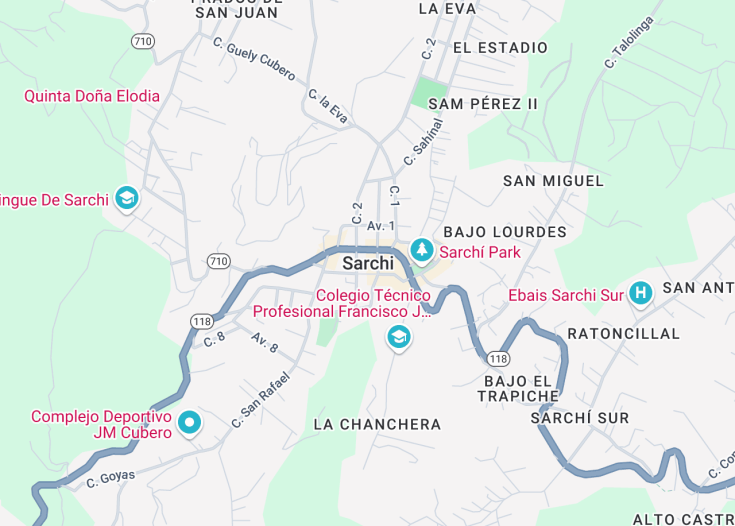Sarchi, nestled in the picturesque valleys of Costa Rica, is renowned for its vibrant arts and crafts, particularly the hand-painted oxcarts that are a national symbol. This charming town offers a unique glimpse into Costa Rican culture, where artisans meticulously create and decorate items with exquisite detail.
Visitors can explore workshops, walk through lush gardens, or witness the traditional craftsmanship that has elevated Sarchi to a celebrated cultural hub known for its contribution to Costa Rican heritage.
When visiting Sarchi, be sure to explore the local art galleries and workshops to purchase authentic, handmade Costa Rican crafts directly from the artists.
Take a guided tour of the Joaquin Chaverri Oxcart Factory to see the artisans at work and learn about the history and significance of the oxcart in Costa Rican culture.
Top things to do & see in Sarchi
Select the following sights and activities to discover best tickets and tours available in Sarchi.
Sarchi: The Artistic Heart of Costa Rica
| Country | Costa Rica |
| Time in Sarchi | GMT-6 |
| Language spoken | Spanish |
| Population | Approximately 2,500 as of 2023 (World Population Review) |
| Currency | Costa Rican Colón (₡ / CRC) |
| Airports |
|
Sarchi, nestled in the picturesque mountains of Costa Rica, is renowned as a vibrant center of traditional arts and crafts. This small town, often referred to as the cradle of Costa Rican artisanship, is especially famed for its colorfully painted oxcarts, which are considered a national symbol. Sarchi’s artisans also produce an array of handcrafted furniture and decorative items that draw visitors from across the globe, making it a pivotal spot for cultural tourism in the region.
Historically, Sarchi began to gain acclaim in the early 20th century when local craftsmen started constructing oxcarts used to transport coffee from the highlands to the coast. These carts were not only functional but also elaborately decorated with exquisite designs, showcasing the skills and artistic visions of the craftsmen. Over the years, these brightly painted oxcarts have become a cultural emblem of Costa Rica, symbolizing strength and resilience, key traits of the national identity.
Today, Sarchi offers visitors more than just traditional crafts. The town is home to several small museums where the history and evolution of Costa Rican folk arts are displayed, in addition to workshops where visitors can see artisans at work. Major festivals and events are often centered around these artisanal traditions, providing a deep insight into the local culture and lifestyle that stands apart from the more commercialized tourist attractions found elsewhere.
The impact of Sarchi on Costa Rican culture extends beyond its artistic contributions. The town serves as a crucial economic hub in the region, supporting numerous families and communities through its vibrant art market. Moreover, Sarchi’s commitment to preserving its traditional crafts can be seen in the growing focus on sustainable practices and eco-friendly methods in their craft production, resonating with wider global values on environmental conservation.
Where is Sarchi?
Sarchi is located in the Alajuela province of Costa Rica, nestled in the Cordillera Central mountain range.
Distances:
| Route | Distance by car | Time by car |
|---|---|---|
| San José to Sarchi | 50 km | 1 hour 10 min |
| Alajuela to Sarchi | 33 km | 45 mins |
| Heredia to Sarchi | 40 km | 1 hour |
What is Sarchi famous for?
Sarchi is most famous for its intricate and colorful oxcarts, a national symbol of Costa Rica. The town is also a significant center for traditional Costa Rican crafts, attracting both locals and international tourists.
History
Pre-Columbian Period – Prior to the 16th Century
The region that is now known as Sarchí, located in the verdant province of Alajuela, Costa Rica, was originally inhabited by indigenous tribes, chiefly the Huetar people. These early inhabitants were skilled in agriculture and handicrafts, elements that foretold the area’s future as a center of craftsmanship. The fertile volcanic soil and abundant rainfall provided ideal conditions for agriculture, a foundation that would underpin the area’s economy for centuries.
Colonial Period – 16th to 18th Century
With the arrival of Spanish colonists in the 16th century, Sarchí began to evolve as part of the greater Costa Rican territory. The Spaniards introduced new agricultural practices and crops such as coffee, which would later become a significant economic driver for the region. However, information specifically pertaining to Sarchí during this era remains sparse, as it was a small and relatively unremarkable community compared to larger colonial settlements.
19th Century – Foundation and Growth
The actual foundation of Sarchí is not well documented but is believed to have occurred in the 19th century as the area’s population grew and the coffee industry began to thrive. The introduction of ox carts, which were essential for transporting coffee from the highlands to coastal ports, marks a significant development in Sarchí’s history. The local artisans started crafting these ox carts, making them vibrant and colorful, a tradition that has become synonymous with the town’s cultural identity.
20th Century to Present – Cultural Renaissance
In the 20th century, while other regions industrialized, Sarchí maintained its focus on crafts, particularly woodworking and ox cart making. These crafts became both a cultural emblem and a significant tourist attraction. Recognizing this, the Costa Rican government designated the elaborately painted Sarchí cart as a national symbol in 1988. Today, Sarchí is renowned not just for its crafts but also as a vibrant community that melds tradition with tourism, demonstrating a unique model of sustainable cultural heritage. The town continues to thrive, preserving its artisanal roots while embracing modernity.
Visit Sarchi
What to see and do in Sarchi
Visiting Sarchí offers a rich tapestry of cultural and natural attractions. Key highlights include:
- The Eloy Alfaro Ox Cart Factory: Explore this historical facility where traditional ox carts are still handmade, offering insight into this artisan craft.
- Sarchí’s Central Park: Featuring a beautifully painted kiosk and surrounded by vibrant gardens, it’s a perfect spot for relaxation and people-watching.
- Local Art Galleries: Discover local artistry in the town’s numerous galleries showcasing woodwork, painting, and crafts.
- Nearby Coffee Plantations: Take a tour of a coffee plantation to learn about one of Costa Rica’s most important exports.
Sarchí is also an excellent base for hiking in the nearby hills and visiting the breathtaking waterfalls in the area.
Festivals and Events in Sarchi
Sarchí hosts a variety of cultural events throughout the year, with the most notable being the Ox Cart Parade (Desfile de Boyeros) held every February. Artisans from across the country gather to showcase their beautifully crafted and painted ox carts in a vibrant display of tradition and pride.
The town also celebrates Costa Rican traditional holidays, such as Independence Day with parades, dancing, and local cuisine.
Best time to visit Sarchi
The best times to visit Sarchí are the dry months from December to April. This period typically offers sunny days and minimal rainfall, allowing for unhindered exploration of the town and its picturesque surroundings.
Is Sarchi worth visiting?
Sarchí is indeed worth visiting, especially for those who appreciate art and culture merged with natural beauty.
This small town offers a unique glimpse into Costa Rica’s famed artisan traditions, particularly through its vibrant, hand-painted ox carts. Coupled with its friendly locals and serene natural landscape, Sarchí presents a compelling destination for tourists seeking a blend of cultural enrichment and relaxation.










